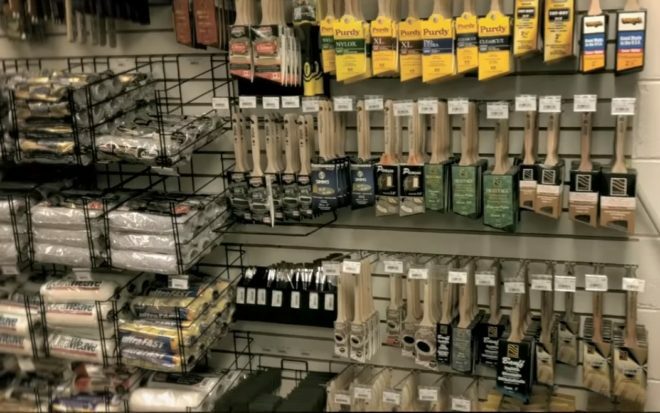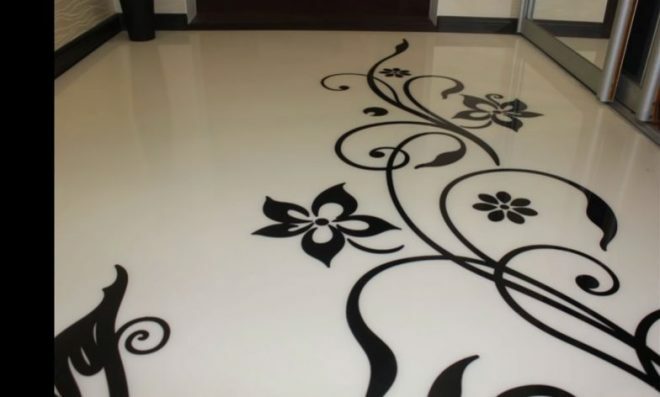- Is linoleum worse / better than tiles and laminate?
- 5 myths about linoleum
- We go to the store - what do you need to know?
- The choice of design and photo in the interior of the kitchen
- Rules for laying linoleum
Linoleum - a floor covering of 6 layers of polymer material, which is available in rolls.
In fact, linoleum is also called wall, completely natural and even produced by type of tile coatings, but in this article we will consider exactly all the familiar PVC coating and learn how to choose the best linoleum for kitchen.
Is linoleum worse / better than tiles and laminate?
There are a number of reasons for explaining why flooring in the kitchen should be made with linoleum, rather than tiles or laminate. Among the main advantages of the material:
- Durability (linoleum 32 and 33 class have a service life of 8 to 15 years);
- High wear resistance - withstands the falling of sharp and heavy objects, suitable for apartments with pets;
- Easy maintenance - washing the PVC coating is very simple. In addition, unlike a laminate and a parquet board, it is easily laundered from spilled beet juice or red wine;
- It has heat and sound insulation properties, it is much warmer than laminate and tiles, in addition, this material can be called the most noiseless;
- A wide range of designs - PVC coating can perfectly imitate the wooden floor with color and relief texture. Today, high-quality linoleum does not immediately distinguish from a parquet board or laminate. But wooden textures are not the only possible design, because there are floor options for tiles, leather or stone. The most popular colors and textures can be found later in the photo of the linoleum in the interior of the kitchen;
- Cost - depending on the manufacturer, type and class of wear resistance, the price varies from 150 to 800 rubles. for 1 square. m;
In the kitchen conditions, the material is acceptable for a price not lower than 350 rubles per square meter.
- Linoleum can be laid easily, quickly and as cleanly as possible, unlike any other flooring;
- Also, you can relatively inexpensively entrust installation to specialists - professional laying of tiles, laminate, parquet board and pouring the filling floor is much more expensive, and their own hands put them harder and more difficult;
- Dismantling the floor of linoleum is very simple, it can also be done by yourself, without a partner and special means.
And now about the shortcomings:
- Heavy furniture may have dents;
- Artificiality of the material - natural materials are always more valuable and beautiful;
- If linoleum is bought at a temperature below + 10 ° C, then you can not roll the roll immediately after purchase. It should be allowed to lie back to him (in a folded form) at room temperature (not below +15 C) 1-2 days. Otherwise, it may crack;
- If you lay it not correctly and not on a leveled base, then it can "float" and from this wear out faster;
- When you join several pieces of linoleum, you will see a seam, but if you match the pattern correctly, the joint will not be as noticeable.
5 myths about linoleum
- "Sex at first looks unpleasant"- modern high-quality material has practically no odor and does not emit harmful substances.
- "Over time, dark / light trails appear on the surface in places where they often walk"- Yes, indeed, on the surface of a household type of linoleum, after several years of operation, abrasions may appear due to frequent washing of the floor aggressive household chemicals, walking in shoes on black rubber, etc. But for coatings 31, 32, 33 of the class laid on an even surface, this defect is not is peculiar.
- "The thicker the linoleum, the longer it will last"- not quite true statement, because now wear-resistant coatings of commercial and semi-commercial type are thicker than household coatings. But the thickness of the transparency (protective layer) plays a big role, it should be at least, mm.
- "Stitches can disperse"- for a new generation of linoleum this problem is no longer relevant.
- "With high humidity under the linoleum, mold forms"- the formation of a fungus under a PVC coating, bedded correctly, is impossible, since it is made entirely of artificial material, and the upper protective layer absolutely does not allow water to pass through. If there was a flood, you just need to bend off the damp part of the linoleum and let it dry. In the event that you are often flooded by neighbors or pipes, it is better to choose a tile.
We go to the store - what do you need to know?
So, how to choose linoleum for the kitchen?
Before going to the store you need to make measurements. Measure:
- Maximum floor width;
- The maximum length of the floor;
- The length and width of the niches and doorways;
To each dimension, you need to add 8 cm (80 mm), so you take into account the irregularities.
Also, you need to determine the type of wear resistance, level of abrasion and type of coating.
Linoleum is divided into 2 groups:
- Homogeneous, that is, a single-layer coating - its thickness is up to 3 mm. Not too popular due to the lack of a variety of color solutions.
- Heterogeneous, multi-layer, up to 6 mm thick. In the structure of this linoleum there are several layers, from durable fiberglass to PVC, plus decorative and protective layers.
The main quality criteria are:
- The abrasion class (according to the European certificate EN660-1) is defined as the degree of wear of the upper protective layer after the abrasive wheel is exposed to certain modes. There are four groups: the strongest T (8 mm), poorly abraded P (5 mm), moderately abradable M (mm), F - highly abradable (up to, mm).
- Level of wear resistance. The European classification EN685 in this case provides for a two-digit marking. The first of them indicates the type of room, and the second shows the level of the maximum load on the floor. These are the same classes of wear resistance, dividing the coating into household, semi-commercial and commercial. For the kitchen, it will be correct to choose a cover not lower than class 23, but optimally - 32-33.
Each subsequent increase in the position leads to the fact that the floor rises in value approximately in, times.
In addition, the dimensions of the material vary - it is supplied in standard rolls of width, -4 meters. If you choose the width of the roll, corresponding to the parameters of the kitchen, then as a result you can make a floor without seams.
The choice of design and photo in the interior of the kitchen
On the floor of the kitchen you can put linoleum with a matte or glossy top layer. It is more expedient to use gloss, because it is easier to care for.
The assortment includes:
- Classic beige-brown imitation wood;
- Imitations of natural stone or ceramic tiles;
- Quality mosaic or parquet images;
- Fantastic textures, patterns;
- Single-color coatings.
Quality linoleum, imitating parquet, will look incredibly authentic. "Wooden" linoleum will fit into any kitchen.
Dust, crumbs, stains are visible on the dark and very light floor. From the point of view of ease of care, it is better to choose brown and gray tones. In addition, dark color conceals space, so it can be placed only in large and light kitchens.
The picture of an aged board on the floor is now in vogue and it will not work out for a long time. Such a floor will decorate the kitchen in the rustic style, classic, Scandinavian and loft (scroll right).
For classical interiors the best solution will be a reliable imitation of ceramics.
The plain linoleum of cold or contrast colors is suitable for the kitchen in the style of hi-tech and minimalism.
If the yardage allows, you can choose the solutions of the brightest colors, with voluminous geometric patterns - it will be appropriate in the styles of eclecticism, pop art, Scandinavian.
To visually increase the space of the kitchen, a light linoleum of cold tones is laid on the floor.
In this case, remember the well-known rule: the transverse strips visually expand the kitchen, and the vertical - extend.
Warm colors of the flooring will make the kitchen more cozy, and bright contrast solutions will add to the room's dynamism.
Rules for laying linoleum
Put the linoleum on the floor with your own hands so simple that even a novice can cope. After dismantling the old floor, you can start work.
The main difficulty is leveling the rough floor and sealing the cracks (after which the entire construction garbage and dust are cleaned very carefully), but this stage is needed for mounting any kind of floor coating.
If you plan to level the base yourself, then a self-leveling self-leveling mixture is best for this. Of course, the laying of linoleum is not carried out until the screed finally dries up.
So, how to lay linoleum with your own hands?
After the base is ready, the roll is rolled up into a room (at a temperature above + 15 ° C) and left for "acclimatization" for 1-2 days. After leveling linoleum, it is cut off. To do it yourself, you need a very sharp construction knife. It is cut easily and smoothly, thanks to the markings on the back side along and across. However, when pruning, leave a technological gap between the coating and the wall - 5 mm. This is necessary for free movement of the material upon shrinkage.
Now you need to fix the linoleum well. For strength, it is glued over the entire area.
Express: you can glue it only around the perimeter with double-sided tape. After that, the material is carefully pressed with plinths.
. Loading...
In this video you can learn more and how to choose linoleum for the kitchen and how to put it yourself on the glue:
Read also:
- . Sex is known in comparison: we choose a floor covering for the kitchen.
- . The floor is in the kitchen.
- . Cork flooring - 99% ideal floor covering for the kitchen.
- . Parquet board in the kitchen - all the pros and cons.
- . All about laminate flooring in the kitchen - from choice to installation.
- . Ceramic tiles in the kitchen - 99% perfect floor.


